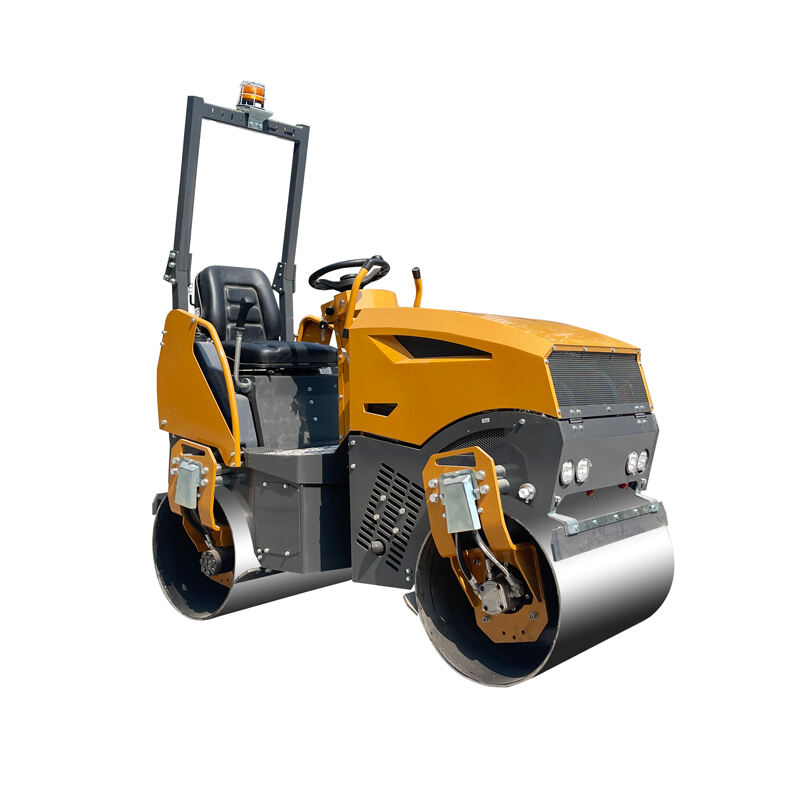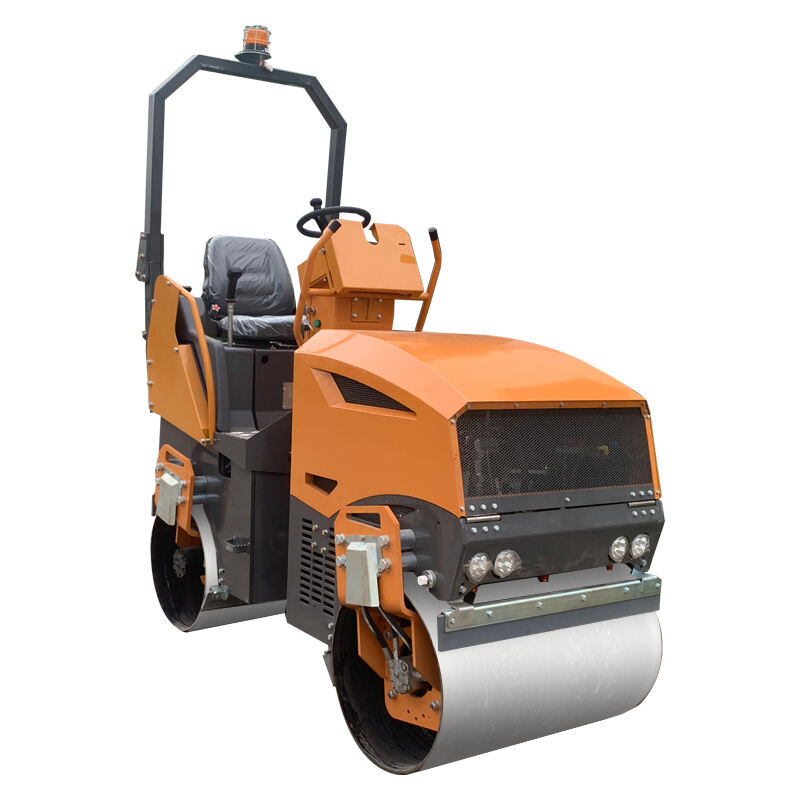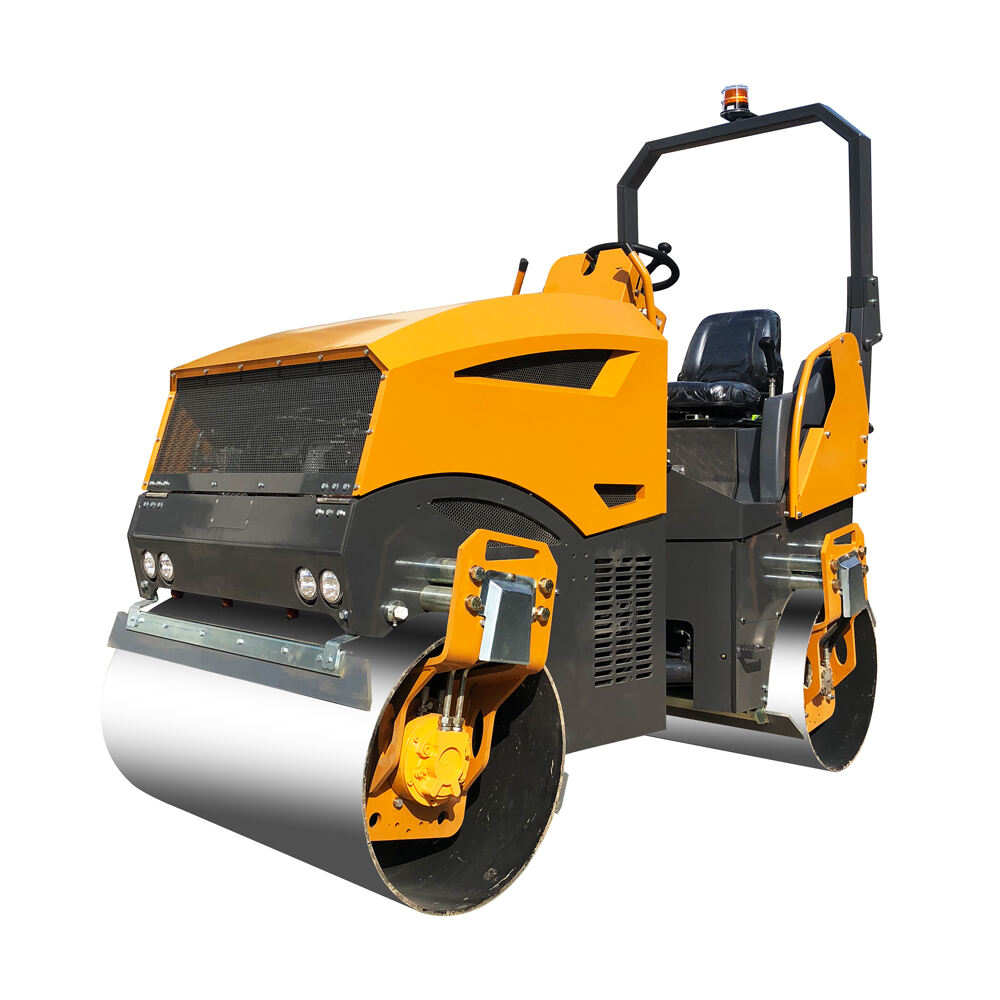Როლიკების კომპაქტორის მოვლის რჩევები
Როლერის კომპაქტორის ძველი კომპონენტები
Მანქანის მოტორის დაცვა: ენერგიის წყაროს აუზი
Როლერის კომპაქტორის ძრავის კარგ მდგომარეობაში შესანარჩუნებლად სრულიად აუცილებელია მუდმივი მოვლა. ზეთის დონის ხშირი შემოწმება და საჭიროების შემთხვევაში ზეთის შეცვლა უზრუნველყოფს მანქანის გაუწყვეტავ მუშაობას. მიუთითებს მწარმოებლის მიერ განსაზღვრული ზეთის ტიპების გამოყენებას, რაც ყველა სერვისული წიგნის მიერ მომხმარებელს გვირჩევს. ოპერატორებმა ყოველთვის ყურადღებით უნდა მოუსმინონ მანქანის მუშაობას, რადგან უცნაური ხმები ხშირად გვიჩვენებს შიდა გაუმართლებას, რომელიც დროულად უნდა გამოვასწოროთ უფრო მძიმე პრობლემების თავიდან ასაცილებლად. სწორად მოვლილი ძრავები უზრუნველყოფს გზის როლერების უკეთ მუშაობას და ამცირებს გაუთვალისწინებელ გამშვიდობებს, რაც ხელს უწყობს მშენებლობის დროში დაგეგმილი სამუშაოების შესრულებას.
Ჟიდების სისტემის შემოწმება: წნევა & გამოსვლები
Ჰიდრავლიკური სისტემა როლერის კომპაქტორების მუშაობაში მნიშვნელოვან როლს თამაშობს, ამიტომ მათი ეფექტუანი მუშაობის უზრუნველსაყოფად საჭიროა მათი ხშირი ინსპექცია. როდესაც ველზე ვარ, ყოველთვის ვუთმობ დროს ჰიდრავლიკური ხაზებისა და კავშირების ყურადღებით შესასწავლად. უმნიშვნელო გადატეკვა მომავალში უფრო მარტივად შეიძლება გამოწვიოს საფრთხეები, რაც შეიძლება მიუყენებელ შედეგებამდე მიიყენებს ან გამოწვიოს კომპონენტების დაზიანებას. ასევე მნიშვნელოვანია სითხის დონის მონიტორინგი, რადგან დაბალი დონე იწვევს სისტემის შეწყვეტას საჭირო წნევის შესაქმნელად და სწორად არ მუშაობს. სტანდარტული მომსახურების ნაწილი უნდა იყოს წნევის ტესტების ჩატარება საიმედო ხარისხიანი მანომეტრებით. ეს დაგვეხმარება პრობლემების ადრე აღმოჩენაში, სანამ ისინი უფრო მარტივად გადასაჭრელ საკითხებად იქცევა. გახსოვდეთ მწარმოებლის მითითებების გადახედვა ამ შემოწმებების დროს, ვინაიდან სხვადასხვა მოდელს შესაძლოა ჰქონდეს კონკრეტული მოთხოვნები. სწორი მომსახურება არ ნიშნავს მხოლოდ წესების მიმდევრობას წიგნიდან, ეს არის მძიმე მანქანების დღიური მუშაობის უზრუნველყოფა და უცხო გასაუქმებების არ მოხდენა.
Გარბენის მომსახურება: ასფალტის აგრეგატის შემცირების პრევენცია
Როლერის კომპაქტორზე დრომს მნიშვნელოვანი როლი აქვს კარგი კომპაქტური შედეგების მისაღებად, ამიტომ პრობლემების თავიდან ასაცილებლად, როგორიცაა დაგროვილი ასფალტის ნაშთები, საჭიროა შესაბამისი მოვლა. ყოველდღიური გასუფთავება უნდა იყოს სტანდარტული პრაქტიკის ნაწილი, ვინაიდან დარჩენილი ლელი მასალა შეიძლება ხანგრძლივობის განმავლობში მანქანის მუშაობაზე უარყოფითად იმოქმედოს. საუკეთესო შედეგების მისაღებად, ჩემი გამოცდილებით, უმჯობესია გამოვიყენოთ სპეციალური საწმენდი ხსნარები, რომლებიც დამუშავებულია იმ მასალისთვის, რომელზეც ვმუშაობთ. ისინი ამოწმენს მაციდან დამაგრებულ ნარჩენებს დრომის ზედაპირის დაზიანების გარეშე. დრომის მუდმივი შემოწმება გახლდათ საჭირო ამოცანა. დახრომილი დრომი ვეღარ უზრუნველყოფს ერთგვაროვან კომპაქტურ ხარისხს, რაც ნიშნავს, რომ მთელი ოპერაცია ნაკლებად სანდოდ ხდება და გრძელვადიან პერიოდში მეტი ფულის დახმარებას მოითხოვს სასწრაფო შეკეთების შემთხვევაში.
Რეგულარული მართვის ჩეკლისტი საუკეთესო გამოistungში
Ყოველდღიური წინადადების შემოწმება
Იმის დაწყება ყოველდღიურად გზის გასწორებელი მანქანების მუშაობის წინ სრული შემოწმებით კარგი აზრია როგორც უსაფრთხოების, ასევე სამუშაოს სწორად შესასრულებლად. ოპერატორებმა უნდა დაიწყონ მნიშვნელოვანი კომპონენტების შემოწმება - გუმბათები, დამუხრუჭების სისტემა, ხილვადობის მაჩვენებლები ზემოდან. ამ შემოწმებების ჩანიშვნების შენახვა შეკვეთის ჟურნალში დახმარებას აკეთებს პრობლემების დროულად ამოსაცნობად, რათა გამოსწორდეს პრობლემები საფრთხის წარმოქმნამდე. ასევე ნუ დაავიწყდებათ უსაფრთხოების სისტემების შემოწმება. ავარიული დამუხრუჭების სისტემა უნდა იმუშაოს სწორად, იგივე შეეხება ყველა გაფრთხილების ნიშნებს. ეს არ არის მხოლოდ სასურველი საშუალებები; ისინი პირდაპირ აცილებენ ავარიებს სამუშაო ადგილებში, სადაც ყველაფერი სწრაფად მოდის და შეცდომები თან ახლდება ადამიანური სიცოცხლეების დაკარგვას.
Კვირიული ჰიდროავალი და ფილტრის წამოწმება
Ჰიდრავლიკური სითხეების შემოწმება და გამოყენებული ფილტრების ყოველკვირეულად შეცვლა არის მნიშვნელოვანი ნაბიჯი იმისთვის, რომ მანქანები არ გაიულისშეუცებლივ გამართული იყოს. როდესაც მომხმარებლები ხშირად ამოწმებენ სითხის დონეს, ისინი დროულად ავლენენ სითხის დაბინძურებას, სანამ ის მოწყობილობის ძვირად ღირებულ კომპონენტებს დაზიანებს. უმეტესი მწარმოებლის რეკომენდაციით ფილტრები უნდა გაიცვალოს ყოველ 500 სამუშაო საათში ერთხელ, ან რომელიც მაინც მოხდება პირველად. ეს მარტივი შენარჩუნების ნაბიჯი სისტემებს უზრუნველყოფს გლუვ მუშაობას წელზე მეტი ვადით, ვიდრე სხვა შემთხვევაში იქნებოდა შესაძლებელი. ავარიული სარემონტო სამუშაოებისა და წარმოების შეჩერების გამო დაზოგილი თანხა სწრაფად იზრდება ნებისმიერი ინდუსტრიული დაწესებულების მრავალი მოწყობილობის შემთხვევაში. იმ საწარმოებს, რომლებიც მკაცრად ასრულებენ შენარჩუნების გრაფიკს, ჩვეულებრივ რამდენიმე თვის შემდეგ უკვე აქვთ ინვესტიციების გამოყენების შედეგად მიღებული დაბრუნება.
Ვიბრაციული მექანიზმების ყოველთვიური ლუბრიფაციის გრაფიკი
Გზის როლერის ვიბრაციული სისტემების ყოველთვიურად მასლით სარგებლობა საჭიროა, რათა ისინი განახლდნენ და შეასრულონ მათზე დაკისრებული მოვალეობები. მიჰყევით მწარმოებლის რეკომენდებულ სმეარსებელ მასალებს, რადგან ეს ნიშნავს საჭირო მომსახურების წესების დაცვას და ხელს უშლის კომპონენტების სწრაფ გატეხვას. მასლის რაოდენობისა და დროის დეტალური ჩანაწერების შენარჩუნება ამარტივებს პრობლემების ადრე აღმოჩენას, სანამ ისინი მნიშვნელოვან საკითხებად იქცევიან. შეგვიძლია დავაკვირდეთ გახანგრძლივების ტენდენციებს და დროულად შევამჩნიოთ დაზიანებული კომპონენტები. ასეთი სახის დეტალური ჩანაწერების შენარჩუნება არა მარტო აგრძელებს მანქანების სამსახურის ვადას, არამედ ამცირებს უცებ მომხდარი გამტეხვების ალბათობას მნიშვნელოვანი სამუშაოების დროს.
Ჩვეულებრივი პრობლემები დომილის კომპაქტერებში და მათი გადაჭრივა
Არაერთნაირი კომპაქტები: გადაწყვეტილების ამოხსნა გრამის მიმართ
Როდის კომპაქტორების გამოყენებით ხდება არათანაბარი კომპაქტობის პრობლემების აღმოჩენა, ეს ჩვეულებრივ მიუთითებს დრომელის გასწორების პრობლემებზე, რომლებზეც ყურადღება უნდა მიექცეს. გასწორების გადამოწმება ხელს უწყობს სამუშაო ადგილზე ერთგვაროვან შედეგების შენარჩუნებას, ვინაიდან არასწორად გაწყობილი დრომელი ვერ მიაწვდება თანაბარ შედეგებს. უმეტესი მწარმოებლები აწვდიან კონკრეტულ რჩევებს დრომელის პოზიციონირების შესასწავალად. ზოგჯერ ასეთი მარტივი გამოსწორება კარგად მუშაობს, მაგრამ როდესაც რამდენიმე ცდის შემდეგ ისინი ვერ ახერხებენ მის აღმასრულებელს, პროფესიონალის მოწვევა გამართულია იმ მტკიცე გასწორების პრობლემებისთვის, რომლებიც არ გადიან.
Ჟიდების სისტემის ვერახლები: გამოსვლის განახლება
Ჰიდრავლიკური სისტემების სითხის დაგროვება გზის როლერებში მაინც არსებობს როგორც მუდმივი პრობლემა, რაც ხშირად გამოიხატება მანქანის ქვეშ წვეთების დაგროვებაში ან უბრალოდ მუშაობის დროს შესრულების დაქვეითებაში. ბევრი ტექნიკოსი ახლა მიმართულია შეღებილი ჰიდრავლიკური სითხეებისკენ, რადგან ისინი ხელს უწყობენ დაგროვების ადგილების მოძებნას ასეთ რთულ სისტემებში, განსაკუთრებით ხელმიუწვდომელი ადგილების გასწვრივ. ამ პრობლემების სწრაფად აღმოფხვრა ძალიან მნიშვნელოვანია, ვინაიდან პატარა დაგროვებების გადაზარდვა მომსახურეობის გარეშე ხანგრძლივი პერიოდების არასასურველი და ძვირად შესრულებული გასართულების მიზეზი ხდება. როდესაც მომსახურე გუნდები დაგროვებებს ადრეულ ეტაპზე ავლენენ და ახერხებენ მათ გამოსწორებას, როლერ-კომპაქტორი გრძელვად უწყობს მუშაობას გლუვად და სანდოდ, რაც საბოლოოდ იწინააღმდეგება ნაწილების შეცვლასა და დაკარგულ პროდუქტიულობას.
Შემცირებული ვიბრაციის ეფექტივობა: ბერინგების შეცვლა
Როდესაც საყრდენები იწყებენ გატეხვას, მაშინ საგზაო რულეტები კარგავენ ზოგიერთ უნარს სწორად იმუშაონ, რაც ზემოქმედებს მასალების დატკეპნის ხარისხზე. საყრდენების გადამოწმება და საჭიროების შემთხვევაში მათი შეცვლა საჭიროა ნებისმიერი პროფილაქტიკური მომსახურების გეგმისთვის. საყრდენის კარგი მდგომარეობა ნიშნავს უკეთ შედეგებს დატკეპნაში, ვინაიდან მანქანა მუშაობს ისე, როგორც იგი შეიქმნა. უმეტესი ოპერატორი იცის, რომ მომსახურების ამ ნაწილის დაუშვებელი მიმართულება მოგვიანებით სხვადასხვა პრობლემებს იწვევს. რეგულარული შემოწმებების დრო იწევს მანქანების გამართულ მუშაობას გასატეხის შორის და დროის გასწრებით ფულის დაზოგვას უზრუნველყოფს, ვინაიდან მოწყობილობა უფრო მეტი დრო გრძელდება შეცვლამდე.
STorike დახურვის მაშინების მოდელები დასანაბირებელი კომპაქტირებისთვის
ST1300 | 1.3-ტონიანი ვიბრაციული დახურვის მაშინი: კომპაქტური ეფექტი
ST1300-ს განსაკუთრებული მართვადობა გააჩნია დიდი კომპაქტური ძალის კომბინაციით, რაც მას სხვა ვიბრაციული როლერებისგან განასხვავებს ბაზარზე დღეს. ამ მანქანის განსაკუთრებული მახასიათებელი არის იმ მოწყენი ადგილებზე მუშაობის უნარი მცირე ზომისა და გონივრული ინჟინერიის საშუალებით, რაც დიზაინშია ჩაშენებული. ბევრი კონტრაქტორის აზრით, მიუხედავად მისი ზომისა, ST1300 არ უშლის კუთხეებს და სანდო შედეგებს აძლევს ყოველდღიურად, რაც მნიშვნელოვანია ქალაქში გარემოში, სადაც თითოეული ინჩი ითვლება. ჩვენ ვნახეთ, რომ ის მუშაობს საუკეთესოდ იმ სამუშაოებში, სადაც უფრო დიდი მანქანები ვერ გაეტეოდნენ, რაც ადასტურებს, რომ ზოგჯერ პატარა მანქანებს შეუძლიათ საქმის სწორად შესრულებაში საკმარისი ძალა მოაქვთ.
ST1800 | 1.8-ტონიანი მოდელი: გამარტივებული ჰიდრაულიკური კონტროლი
ST1800 ვიბრაციული როლერი იკვეთს უკეთესი ჰიდრავლიკური სისტემით, რამაც საშუალება გაუწია სხვადასხვა ტვირთებთან მუშაობა გაცილებით უფრო მარტივად. მანქანას აქვს სერიოზული გაუმჯობესებები საწვავის დასაზოგად, ამიტომ ხანგრძლივად გამოყენებისას ფასის მხრივ ნამდვილად აღემატება ძველ ვერსიებს. ადამიანები, რომლებიც ამ მანქანებით სარგებლობენ, აღნიშნავენ, თუ როგორ უსწორდება ის სხვადასხვა სახის მიწას, ჩაურთვა მაგრამ მაგრივ მიწიდან ქვიან ზედაპირებამდე. ასეთი საშუალებების გამოყენება აჩვენებს, თუ რამდენად ჭკვიანურად არის შექმნილი ეს მოწყობილობა. მშენებლები განსაკუთრებით აფასებენ იმას, რომ მათ ჰყავთ სანდო რამე, რაც შეუჩერებლივ იმუშავებს მუდმივი გასწორების გარეშე, არა მარტო უცნაური ტერიტორიების შემთხვევაში, რომელიც სამუშაო ადგილზე შეიძლება შეხვდეს.
ST2000 | 2-ტონიანი გადაწერილი: ორი ვიბრაციული რეჟიმი
ST2000-ის განსაკუთრებულ რამეს წარმოადგენს მისი ორმაგი ვიბრაციის სისტემა, რომელიც საშუალებას აძლევს მუშებს მოხმარონ სხვადასხვა სახის კომპაქტური სამუშაოების შესრულებისას. მანქანას შეუძლია გადართოს რეჟიმები დამოკიდებულებით იმაზე, თუ რა მასალა უნდა დაკომპაქტდეს, არის თუ არა ის ხრომი ქვა თუ მკვრივი თიხა. სამაგისტრო ტესტირების შედეგები აჩვენებს, რომ ეს მოწყობილობა უსმევს ყველაფერს გზის საფუძველიდან საფუძვლის გარშემო უკან შეყვანილი მუშაობამდე. მომხმარებლებს ასევე მოეწონათ მანქანაში გამართული დიზაინის ელემენტები. ერგონომიური სამართველი ამცირებს დაღლილობას გრძელი სამუშაო დღეების განმავლობაში, ხოლო უსაფრთხოების საშუალებები, მაგალითად, ავარიული გამართვის ღონის დამაგრებული ადგილები ხელმისაწვდომია საჭირო ადგილებში. ბევრი მშენებელი გუნდისთვის ST2000-ზე გადასვლა მოხდა, ვინაიდან არავის უნდა სურდეს გუნდის მუშაობა უხერხულ ინვენტარში, როდესაც უკვე არსებობს უკეთესი ვარიანტები.
ST3000 | 3-ტონიანი მძიმის როლის მძიმი
Დაპროექტებულია როგორც მძიმე სამუშაოებისთვის, ST3000 ვიბრაციული როლერი გახდა აუცილებელი მოწყობილობა სერიოზული სამშენელო სამუშაოებისა და გზების მუდმივი შესანარჩუნებლად. რაც ნამდვილად განასხვავებს ამ მანქანას, არის მისი მარტივი კონსტრუქცია, რომელიც უძლებს დიდი პროექტებს გასატეხად, რაც გულისხმობს სარემონტო სამუშაოების და დაუსვენებლობის შემცირებას დროის განმავლობაში. იმ კონტრაქტორებმა, რომლებმაც მუშაობა მოახერხეს ST3000-ზე, ხშირად ახაზგასმულია მისი მაღალი ხარისხი და მაღალი წნევის მიუკიდებლად მუშაობა, განსაკუთრებით როდესაც საქმე გაქვთ უხეშ ტერიტორიასთან ან დახურულ ვადებთან. ბევრი ამ როლერის გამოყენება ხორციელდა თვეების განმავლობაში მნიშვნელოვან საავტომობილო გზების პროექტებზე, სადაც სანდოობა ყველაზე მეტად მნიშვნელოვანია. ნებისმიერისთვის, ვისაც სურს მეტის გაკეთება გახშირებული სარემონტო სამუშაოების გარეშე, ST3000 უზრუნველყოფს მუდმივ შედეგებს დღედან დღეში, რაც ეხმარება გუნდებს მუშაობის შენარჩუნებაში თუნდაც პირობები რთული იყოს.
ST2000C | კომბინირებული გადაწყვეტი და ტირის დიზაინი
ST2000C-ს აქვს ეს საინტერესო კონფიგურაცია, რომელიც აერთიანებს როგორც ბარაბანის, ასევე გუმბათის მოდიფიკაციებს, რაც მას საშუალებას აძლევს გაუმკლავდეს ნებისმიერი სახის უმაღლეს ხარისხის ნივთიერებებს. მისი წონის ზემოქმედების გადანაწილების მეთოდი უზრუნველყოფს მასალის უფრო მკაცრ დატკეპნას, ამიტომ პროექტების შედეგები უკეთესია, ვიდრე სტანდარტული მოწყობილობების გამოყენებისას. ჩვენ აღვნიშნული მანქანის გამოყენების დროს აღმოჩნდა, რომ ის განსაკუთრებით კარგად მუშაობს აგებულების ადგილებზე, სადაც ირეგულირებს ტერიტორიებს ან არის მრგვალი და მკვრივი ნიადაგის შერეული ზოლები. მომხმარებლებმა აღნიშნეს, რომ მიუხედავად იმისა, რომ ის საკმარისად სწრაფად მუშაობს და დროის განრიგს შეინარჩუნებს, ის კარგად ერგება ველზე არსებულ არალოდინი შეფერხებებს. სიჩქარისა და მოქნილობის ეს კომბინაცია ახსნის, რატომ უამრავი მომხმარებელი ბრუნდება უკან და ირჩევს ST2000C-ს მისი პირველი გამოცდილების შემდეგ.
 EN
EN
 AR
AR CS
CS DA
DA NL
NL FI
FI FR
FR DE
DE IT
IT NO
NO KO
KO PL
PL PT
PT RO
RO RU
RU ES
ES SV
SV TL
TL ID
ID LV
LV SR
SR SK
SK SL
SL VI
VI SQ
SQ ET
ET TH
TH TR
TR AF
AF MS
MS GA
GA HY
HY KA
KA BS
BS LA
LA MN
MN MY
MY KK
KK UZ
UZ KY
KY












